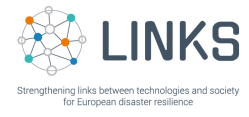
The main objective of the LINKS project is to strengthen European disaster resilience by consolidating knowledge and generating learning on the uses of social media and crowdsourcing (SMCS) in disaster management processes within the LINKS Framework. To gather this knowledge, we conduct research activities in five practitioner-driven case scenarios in Europe:
Case 1: Earthquakes in Italy
Case 2: Industrial hazards in the Netherlands
Case 3: Drought in Germany
Case 4: Flooding in Denmark
Case 5: Terrorism in Germany
The first round of case assessments took place between November 2021 and March 2022. LINKS partners in each case country, conducted an extensive set of interviews, held workshops, and distributed an on-line survey, aimed at gathering information on the experiences, good/best practices and needs of disaster management organizations (DMOs), for working with SMCS technologies in disaster management processes. The research was guided by methodologies developed in LINKS (D2.3: Bonati, S. & Pazzi, V. 2021; D3.2: Bach Nielsen, A. et al., 2021; D4.2: Gehlhar S. et al., 2021), with specific focuses on thematic areas relating to decision making procedures, sensitivity to vulnerabilities, credible information, learning across phases, and technical aspects of the SMCS tools and processes currently being employed by DMOs.
The first analysis from the interviews and survey confirmed results from the desk studies (D2.1: Bonati, S. 2020; D2.2: Pazzi, V,. et al. 2020; D3.1 Nielsen, A. & Raju, E., 2020; D4.1 Habig, T., et al. 2020) conducted earlier in the project, pointing to a strong interest by disaster management organizations for engaging with SMCS in disaster management processes, but overall a lack of:
- Good/best practices and procedures among institutions in Europe, on how to use SMCS in efficient ways.
- Relevant and easy-to-use guidelines on implementing SMCS in disaster management processes.
- Understanding of the potentials, and guidance on how to include citizens in disaster management processes.
- A comprehensive and understandable overview of existing solutions/technologies.
In light of these overall findings, some key takeaways from the study included that the procedures and experiences for using SMCS by DMOs are often unstandardized, informal, and ad- hoc. Barriers for integrating formal procedures include (among other things) timing and managerial constraints; lack of knowledge on, training and resources for using SMCS technologies; and knowledge loss owing to staff turnover. In addition, the research found that experiences and needs are largely orientated towards disaster response and preparedness activities, with little attention paid to recovery and prevention phases.
Another interesting finding was that the concept and applications of crowdsourcing in disasters is far less considered by DMOs in comparison to social media. In fact, the active engagement with citizens is a divisive topic among DMOs, with some focused on the potential benefits and others the risks. This appears to be linked to a number of factors including an unwillingness or inability (owing to lack of know-how) to involve external stakeholders in disaster management activities, and general unfamiliarity with the potentials and benefits of crowdsourcing due to inexperience using it. In a similar way, a focus on vulnerability by DMOs was considered less, with few concrete examples found of how DMOs address vulnerable groups in disasters through SMCS. Most organizations did not differentiate among types of groups and citizens in terms of the targeting of tailored risk communication and other applications of SMCS in disasters. However, some DMOs did recognize a need for it.
The full report on the first results from the cases will be available in late 2022 in the LINKS deliverable 6.4: First LINKS Case Report. The results are currently undergoing a second round of analysis which will inform the ongoing development of the LINKS Framework. A second round of case assessments is set to begin in November 2022.
To know more, also read our deliverbales:

